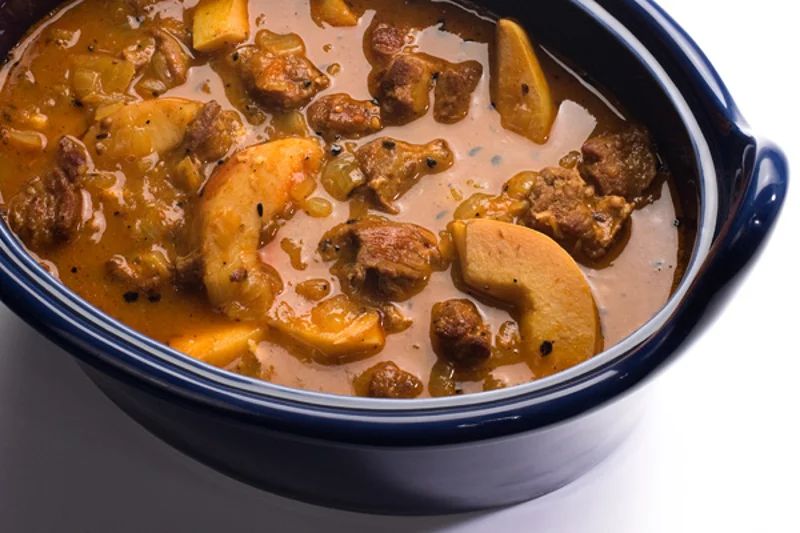Tunisian cuisine is full of spice and complexity, and this stew is no exception. Marinating the meat overnight allows the coriander, caraway, and other spices to flavor the lamb, while the addition of quince creates a pleasant sweet-sour note.
Game plan: Be sure to cook the stew at a low, consistent temperature to ensure tender, juicy meat. And as with any stew or braise, this dish is best the next day, after the flavors have had a chance to meld.
This recipe was featured as part of both our Chile Pepper Recipes and Fall Ingredients photo galleries.
- Yield: 6 servings
- Difficulty: Easy
- Total: 4 hrs, plus marinating time
Ingredients (17)
- 2 tablespoons coriander seeds
- 1 tablespoon caraway seeds
- 6 medium garlic cloves, peeled and smashed
- 3 dried arbol chiles, crumbled
- 2 teaspoons paprika
- 1 teaspoon cayenne pepper
- 5 tablespoons olive oil
- 3 pounds lamb shoulder, cut into 3-inch cubes
- Kosher salt
- Freshly ground black pepper
- 2 medium yellow onions, medium dice
- 2 tablespoons tomato paste
- 1 (2-inch) cinnamon stick
- 1/2 teaspoon crushed saffron
- 5 cups low-sodium chicken broth
- 2 pounds quince (about 6)
- 2 tablespoons honey
Instructions
- Toast the coriander and caraway seeds in a small, dry frying pan over medium-low heat until the seeds release their aroma and darken slightly, about 4 minutes. Remove from the pan and let cool at least 5 minutes. Transfer the seeds to a resealable plastic bag and pound them with a rolling pin or meat mallet until coarsely crushed but not pulverized.
- In a large nonreactive bowl, combine the crushed seeds with the garlic, chiles, paprika, cayenne, and 2 tablespoons of the olive oil. Stir, then add the lamb and toss until the meat is well coated. Cover and refrigerate 8 to 12 hours.
- Take the meat out of the refrigerator and transfer to a large plate or baking sheet, reserving the garlic from the marinade. Season the meat well with salt and pepper and let it sit at room temperature for 45 minutes.
- When the lamb is ready, heat the remaining 3 tablespoons oil in a 4-quart Dutch oven or a heavy-bottomed pot with a tightfitting lid over medium-high heat until shimmering. Add the lamb in batches to prevent overcrowding and cook until a dark brown crust has formed on all sides, about 10 minutes per batch. Once the lamb is browned, remove to a plate and discard all but 2 tablespoons of the oil.
- Add the onions, tomato paste, cinnamon stick, reserved garlic, and saffron to the remaining oil in the pot and sauté over medium-high heat. Using a wooden spoon, scrape up any browned bits that have stuck to the bottom of the pan and continue cooking until the onions begin to caramelize and soften, about 10 minutes. Season well with salt and pepper. Return the lamb to the pot and add the broth. Cook, covered, at a gentle simmer for 1 1/2 hours.
- Once the lamb is almost knife tender, prepare the quince by running them under cold water to rub any fuzz off the skin. Cut each quince into 8 wedges, remove the cores, and add them to the stew. Stir in the honey and cook until the lamb and quince are tender but not falling apart, about 1 hour. To test that the lamb is done, remove a piece from the pot and set it on a clean plate. Press it with your thumb or the back of a spoon. If it yields easily and almost falls apart, it is done; if it resists pressure, return it to the pot and continue cooking.
- When the lamb is ready, taste the stew for seasoning and add more salt if necessary. Serve with couscous, farro, or steamed rice and Harissa.
Beverage pairing: Bonny Doon Le Cigare Volant, California. Though made in California, this wine is fashioned after the French Châteauneuf-du-Pape. Its Golden State origins, though, ensure that it has lots of wild blackberry and plum flavors to complement the lamb. The blend of Rhône grapes also gives the wine a complex mix of spices perfect for this stew’s Tunisian influence.


